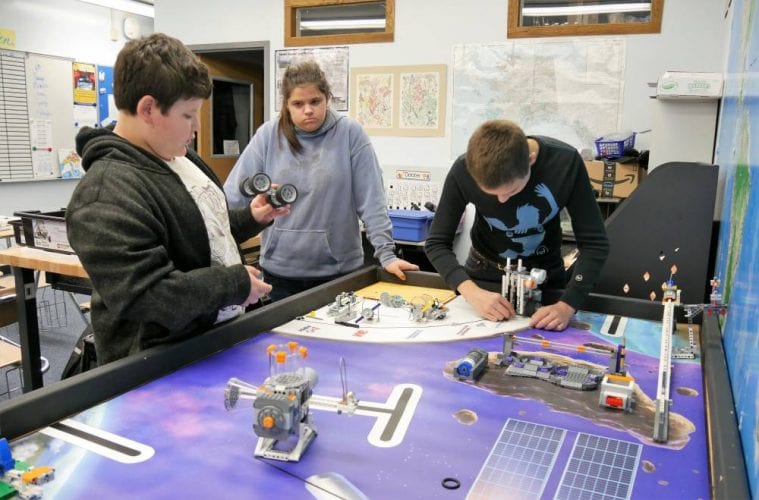
Three 8th grade students in Petersburg Junior High Robotics Club work together on the team’s robot. (L-R) Enrique Lyons, Kate Byrer, Malcolm Fry. (Photo by Angela Denning/KFSK)
Hundreds of tiny Legos, that’s what 8th grader, Malcolm Fry, is sifting through to help create a fork lift system for his team’s robot.
Fry is joined by two other 8th graders in the search. They look through several boxes on top of classroom desks. In the mix are traditional block-shaped Legos and “bionic” ones made for specific functions. They’re the tricky pieces.
“They’re like the special looking ones,” said Kate Byrer. “I have some sets that have these long pieces except I get confused all the time.”
Problem solving is what the robotics club is about. The three students carry potential Lego pieces to a nearby table the size of a ping pong table that’s covered with images of outer space. Space is the theme of this year’s robotics competition that the students are working on. Several Lego structures are set up in different areas of the table; each one is a mission challenge for the robot. There are 15 in all and the goal for the season is for the robot to do as many as possible. The missions represent tasks that astronauts might be doing in space.
To get the robot to accomplish the missions the students build what are called add-ons to the robot.
“Like the one I’m building right now is meant to do several tasks on this board,” Fry said.
Byrer says they control the robot add-ons through a laptop computer.
“We tell the computer to make this certain motor or certain wheel move a certain amount so it can go as far as it needs to so I can help out with the mission,” Byrer said. “And we have to put a whole lot of codes together just to finish one mission.”
Cyndy Fry is the robotics coach (and Malcolm’s mom).
“They have to adapt the robot that they build to run maneuvers,” she said. “They actually have to pick up the pods and set them on the ramp, they have to put part of the shuttle together, they have to move an astronaut and do a little moon walk with him and then put him back into the capsule.”
“Do you know how to do all this stuff?” I asked her.
“No, I don’t know how to do any of this,” she said. “My job is just to be here to support, to help them facilitate communication, to give them a place and a time to do this but my job as coach is just to provide them the opportunity.”
Petersburg has three teams of three in the 7th and 8th grade. Each team is trying to figure out how to program the robot for five of the 15 missions. On December 8th, they will all come together to compete in Juneau to see how many missions they can complete in a certain amount of time.
Enrique Lyons is in his second year on the robotics team. Last year he built an arm for the robot, which he says helped with missions.
“I think it’s fun to program the robot and build to it,” Lyons said. “It takes quite a while but it works out later in the actual challenge.”
Working with the robot is only one-third of the competition. The teams must also come up with a problem found in space that they could potentially resolve. And thirdly, they will be judged on their knowledge of the competition’s core values, which include collaboration and team work.
It’s the third year for Petersburg to participate. Last year the team took 14th place.
Petersburg’s sixth graders also have two robotics teams with 11 participants. They will be competing against other schools through a virtual tournament since they are too young to travel.









